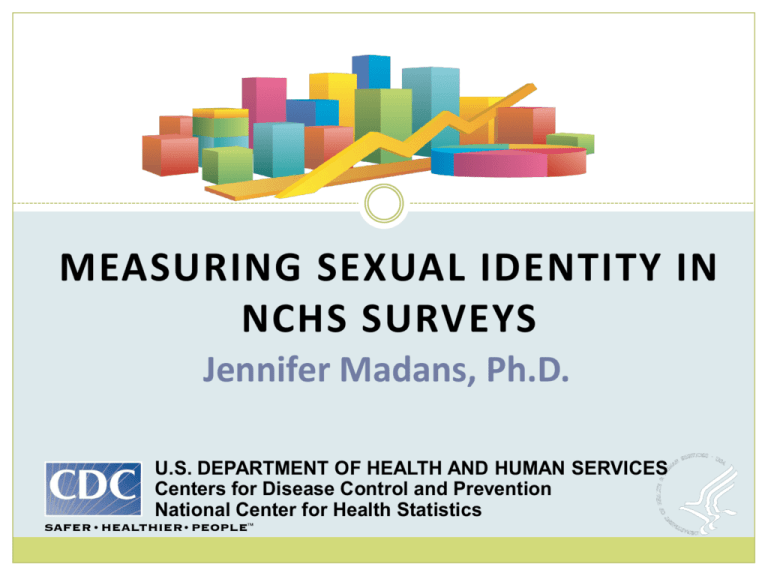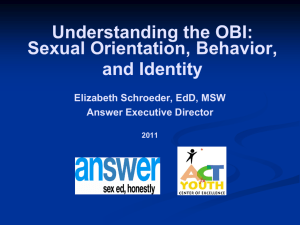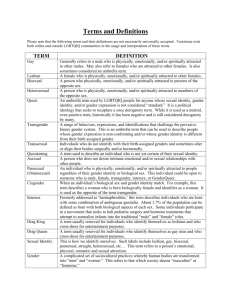
MEASURING SEXUAL IDENTITY IN
NCHS SURVEYS
Jennifer Madans, Ph.D.
U.S. DEPARTMENT OF HEALTH AND HUMAN SERVICES
Centers for Disease Control and Prevention
National Center for Health Statistics
NCHS Staff
NSFG
Anjani Chandra
Casey Copen
Bill Mosher
Catlainn Sionean
NHIS
Marcie Cynamon
Jim Dahlhamer
Beth Taylor
QDRL
Heather Ridolfo
Kristen Miller
Aaron Maitland
Mike Ryan
Background
Need to better understand health of sexual
minority groups
Some evidence of health disparities
Challenges to Researching
Sexual Minority Health
Conceptual Complexity Survey design
Sexual
identity
Sexual attraction
Sexual behavior
Fluidity of identity
Comprehension of
terms
Commonality of terms
Population subgroup
differences
Context
of questions
Incorporation into
ongoing survey
Consideration of future
survey changes
Definition of Construct
Sexual Orientation:
Generic term, catch-all
Sexual Behavior:
Same-sex vs. opposite-sex behavior
Not necessarily consistent with self-conception or presentation of self
Design problem: what counts as “sex” varies across sub-groups
Sexual Attraction:
Same vs. opposite sex/gender desire
Not necessarily consistent with self-conception or presentation of self
Latent and elusive phenomena, not tangible, not observable
Design problem: Variation in conceptualization, particularly in what respondents consider
and actually report
Sexual Identity
Conscious understanding and identification of self
Similar to racial identity
Represents individuals’ relationship to social world
Design problem: complex and fluctuating
Patterns of Interpretation/Construct Equivalence
Non-Minority Patterns
Lack of salient sexual
identity
No concept of sexual identity but
rather dis-identification
“not me,”
“I’m normal,” “soy mujer,”
“I don’t know”
Provided response categories:
Interpretation of ‘heterosexual’ as gay;
‘bisexual’ as heterosexual
LGBT Patterns
Highly salient
Identity rooted in complex
process of negotiating and forming a
sexual identity
Shifting sexual identity
For transgender respondents,
intersection of gender
and sexuality
Provided response categories:
Use of non-traditional
identity categories
Results Thus Far
National Survey of Family Growth (NSFG)
National Health and Nutrition Examination
Survey (NHANES)
Questionnaire Design Research Laboratory
(QDRL)
NSFG Cycle 6 (2002)
Do you think of yourself as…
Heterosexual
Homosexual
Bisexual
or Something else
NSFG Cycle 6 (2002)
Table 1. Sexual identity by gender.
Sexual Identity
Men
Women
All
Heterosexual
90.2%
90.3%
90.3%
Homosexual
2.3
1.3
1.8
Bisexual
1.8
2.8
2.3
Missing
5.7
5.6
5.6
100
100
100
55,399
55,742
111,141
Weighted N in
thousands
Note. Missing data= something else, refused, and don’t know responses
NHANES 2002-2008
Do you think of yourself as…
Heterosexual or straight (attracted to men/women)
Homosexual or lesbian/gay (attracted to women/men)
Bisexual (attracted to men and women)
Something else
Not sure
NHANES 2002-2008
Table 2. Sexual identity by gender.
Sexual Identity
Men
Women
All
95.4%
93.2%
94.3%
Homosexual or gay/lesbian
2.3
1.5
1.9
Bisexual
1.3
3.3
2.3
Missing
1.1
2.0
1.6
100
100
100
(3697)
(4201)
(7898)
Heterosexual or straight
n
Note: Missing data = something else, not sure, don’t know, refused and
don’t know responses
NHANES 2002-2008
Table 3. Distribution of missing data by education
Men
Women
Missing data
<HS
HS
>HS
<HS
HS
>HS
Yes
3.4%
0.8%
0.4%
5.7%
2.1%
1.1%
No
96.7
99.2
99.6
94.3
98.0
99.0
100
100
100
100
100
100
(976)
(995)
(1724)
(976)
(918)
(2306)
n
Chi-square = 42.34, p<.0001
Chi-square = 50.29, p<.0001
NHANES 2002-2008
Table 4. Distribution of missing data by gender and ethnicity.
Men
Missing data
Women
Hispanic
Non-Hispanic
Hispanic
Non-Hispanic
Yes
3.4%
0.6%
5.8%
1.3%
No
96.6
99.4
94.2
98.7
100
100
100
100
(1103)
(2594)
(1247)
(2954)
n
Chi-square = 42.10, p<.0001
Chi-square = 46.06, p<.0001
Note. Missing data = something else, not sure, refused, and don’t know
responses
NHANES 2004-2008
Table 5. Distribution of missing data by language and ethnicity (for
women only).
Missing data
Hispanic
Hispanic
Non-Hispanic
English interview
Spanish interview
English interview
Yes
3.3%
9.9%
1.4%
No
96.7
90.1
98.6
100
100
100
(496)
(426)
(2169)
n
Note. Chi-square = 43.85, p<.0001
Results
High
rates of missing data in
comparison to the target group
(something else, not sure, don’t know,
and refused responses)
Unevenly distributed across
population
Higher
among low education
Higher among minority population
NSFG 2006-2008
Do you think of yourself as…
Heterosexual or straight
Homosexual or gay/lesbian
Bisexual
or Something else
When you say “something else” what do you
mean? Please type in your answer
NSFG 2006-2008
Table 6. Sexual identity by gender. United States, aged 1844, 2006-2008
Sexual Identity
Men
Women
All
Heterosexual
95.7%
93.7%
94.7%
Homosexual
1.7
1.1
1.4
Bisexual
1.1
3.5
2.3
Missing
1.5
1.7
1.6
100
100
100
55,556
56,032
111,588
Weighted N in
thousands
Note. Missing data= something else, refused, and don’t know
responses
NSFG 2002 and 2006-2008
Table 7. Percent missing data for sexual identity by selected
characteristics: United States, aged 18-44, 2002 and 2006-2008
Men
Women
2002
2006-08
2002
2006-08
Hispanic
10.8
4.5
10.2
4.8
NH White
3.0
0.5
3.5
0.9
NH Black
10.7
0.4
8.5
2.2
ACASI -English
5.4
0.9
5.1
1.2
ACASI-Spanish
12.0
8.5
12.6
9.2
Ethnicity
Language
Note. Missing data= something else, refused and don’t know responses
NSFG 2002 and 2006-2008
Table 7 Continued. Percent missing data for sexual identity by selected
characteristics: United States, aged 18-44, 2002 and 2006-2008
Men
Women
2002
2006-08
2002
2006-08
Less than HS
12.7
3.9
15.1
4.2
HS
8.7
1.5
8.4
1.1
Some college
1.7
0.8
2.5
1.1
Bachelor’s degree
or higher
1.3
0.7
1.5
1.0
Education
Note. Missing data= something else, refused, and don’t know responses
NSFG Results
2006-2008 NSFG
Significantly
improved question wording
Lower rates of missing data
Still high rates of missing in some populations
Lowest educational level
Spanish speaking, especially women
Women: BMI by ‘Sexual Orientation’
2002 NSFG
Normal
Overweight
HETEROSEXUAL
49.7
25.6
HOMOSEXUAL
30.5
35.3
BISEXUAL
48.5
29.6
Obese
24.7
34.2
22.0
2006 NSFG
Normal
Overweight
Obese
STRAIGHT OR
HETEROSEXUAL
40.7
26.5
32.8
GAY OR LESBIAN
OR HOMOSEXUAL
38.2
33.0
28.8
BISEXUAL
36.5
19.5
44.0
Preparing to Add Questions to the NHIS
What’s different about the NHIS?
Multipurpose
General Population Survey
Interviewer Conducted Interview
Areas Needing Development
Audio
Computer Assisted Self Interview
(ACASI)Development
Question Development
Sources Informing NHIS Question
Development
Quantitative Studies
2001-2008 National Health and Nutrition Examination Survey
(NHANES)
2002 -2003 National Survey of Family Growth (NSFG)
2006-2008 NSFG
Qualitative Studies
7 cognitive testing study results
This project 139 interview
Total 377 cognitive interviews
139 Cognitive Interviews conducted
139 Cognitive Interviews conducted
Design for New Question
Goals for New Question:
1. Reduce misclassification, especially for non-minorities
2. Reduce “something else” and “don’t knows”
3. Sort non-minority from minority cases
Revision Based on Principles:
1. Use labels that respondents use to refer to themselves
2. Do not use labels that respondents do not understandespecially if not required by any respondents
3. Use follow-up questions to meaningfully categorize
‘something else’ and ‘don’t know’
Revised sexual identity question
Do you think of yourself as…
Lesbian or gay
Straight, that is, not lesbian or gay
Bisexual
Something Else
Don’t Know
Revised sexual identity question
By something else, do you mean that…
You are not straight, but identify with another label such as queer, trisexual,
omnisexual or pan-sexual
You are transgender or transexual
You have not or are in the process of figuring out your sexuality
You do not think of yourself as having a sexuality
You personally reject all labels of yourself
You made a mistake and did not mean to pick this answer
You mean something else
What do you mean by something else?
Please type in your answer
_____________________________________
Revised sexual identity question
By Don’t Know, do you mean that…
You don’t understand the words
You understand the words, but you have not or are in the process of
figuring out your sexuality
You mean something else
What do you mean by something else?
Please type in your answer
_____________________________________
Additional work
Limitations:
Washington DC metro region
Different vocabulary can vary (particularly true for Spanish)
Question still being evaluated/may change with:
Field interview debriefings
Analysis of field test data
NHIS
THREE PHASE TEST
The National Health Interview Survey
Since 1957
General health survey
Noninstitutionalized population
In person interviews by Census interviewers
n = 40,000 households, national sample
Data on households, adults, and children
Annual , one time, and periodic content
One hour
Advance letter/informed consent
Phase 1: Bridging Field and Lab Techniques
n = 50
Maryland, Virginia, and Pennsylvania
6 interviewers
Adapting QDRL procedures to Census field
requirements
Context of NHIS
Transition from standard CAPI to ACASI
Phase 2: Testing Technical Procedures
n = 500
Several regions
Full NHIS with ACASI at the end
Tests procedures for
Using
headphones
Delivering instructions
Respondent concerns
Input and output
Phase 3: The Pilot
N = 5,000
Split Ballot
ACASI compared to CAPI
Additional issues and experimentation
Spanish
Question
wording, order
Voice qualities (human or text to speech; sex;
speed)
Placement
Evaluation Criteria
Break off rates
Nonresponse
Don’t know and refused responses
Impact on other survey data
Interviewer debriefing
Observer debriefing
Comparisons to other surveys
Timeline
Date
Activity
Nov-Dec 2011
Phase 1
Apr-May 2012
Phase 2
Aug-Sep 2012
Phase 3
Jan 2013
Full Implementation
NHIS Pretest
Stay tuned….





